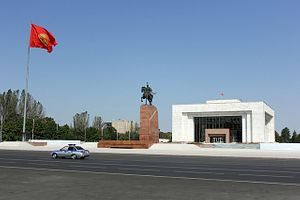In just under eight months, Kyrgyzstan will elect 120 deputies to form its seventh national parliament. As with many elements of Kyrgyzstani politics, the cast of characters and their respective triumphs and tribulations can get overwhelming. Over two pieces, I’ll look at the current state of Kyrgyzstan’s party landscape and explain the effect of electoral rules on party behavior and democratic accountability.
Kyrgyzstan’s Ministry of Justice reports 255 registered political parties in Kyrgyzstan (15 of which were founded since 2019), but only a handful are active and even fewer are well-positioned to win seats in the parliament, called Jogorku Kengesh in Kyrgyz.
A seemingly obvious place to look for clues about which parties will do well in October’s elections is the current parliament. Six parties hold seats in Kyrgyzstan’s current and sixth parliament: former President Almazbek Atambayev’s Social Democratic Party of Kyrgyzstan (SDPK), the Kyrgyzstan Party, Ata-Meken, and Onuguu-Progress made up the majority coalition, while Bir Bol, Respublika-Ata Jurt, and three independent deputies form the opposition.
What’s surprising about early speculation about the next parliamentary election is that none of the currently sitting parties are seen as front-runners. Recent fractionalization of the dominant parties and the emergence of new players means that this year’s parliamentary elections will be especially competitive.
It’s easy to assume the SDPK would continue to dominate in parliament, given that the party has been at the top of Kyrgyzstan’s political sphere for almost a decade. But the party has more or less imploded since the falling out between President Sooronbay Jeenbekov and his predecessor Atambayev. In April 2019, a breakaway segment of the SDPK organized a party congress and re-registered with the Ministry of Justice under new leadership, but Atambayev loyalists organized a counter-congress and insist that they still run the real SDPK.
Other well-known factions have also suffered from infighting. Respublika-Ata Jurt — former presidential candidate Omurbek Babanov’s party — split in December 2019. While each constitutive party will participate in local elections in April, it’s not clear whether they will be competitive at the national level in October.
As major parties with widespread name recognition struggle with fractionalization, how are other parties in Kyrgyzstan’s political landscape faring? Three up-and-coming parties are worth paying attention to.
Local analysts have identified Birimdik as a strong candidate for October’s elections. Birimdik not a new party per se; it was founded back in 2005 and pooled its candidates with former Prime Minister Felix Kulov’s party Ar Namys in the 2010 national parliamentary elections. Birimdik didn’t participate in the 2015 elections, and it seemed the party was dead. But in late 2019, Marat Amankulov — who defected from the SDPK rather than choose a side in the split — re-registered the party. Since then, Birimdik has drawn politicians from other major parties onto its candidate list.
Like Birimdik, the Liberal Democratic Party of Kyrgyzstan is not a new enterprise; it was founded in 2011, but has been inactive ever since. Janar Akayev — previously a journalist for Azattyk Radio and Almazbek Atambayev’s press secretary — revived the party in January 2019. Akayev, who was expelled from the SDPK in 2017, says he plans to focus on the young, progressive demographic.
Mekenim Kyrgyzstan was founded a few weeks after the 2015 national parliamentary elections and ran candidates in 2016 local elections. The party founders’ identities are unknown to the public, but local news outlets have concluded that party leadership is made up of entrepreneurs with links to the Matraimovs, a powerful and deeply divisive family that was recently implicated in a major corruption scandal.
It’s still too early, to make any definitive predictions about the national elections in October. Several major cities will hold local council elections in April – these races are hotly contested, and reports of industrial-level bribery are already emerging. For the newer parties mentioned above – and other smaller parties that I didn’t cover – local elections will be an early test for viability at the national stage.
Party success doesn’t exist separate from the rules and institutions that govern elections in Kyrgyzstan, however. In the next piece, I’ll look at how electoral rules – specifically the double threshold parties must meet to gain seats in parliament – shape parties’ campaign incentives.
































